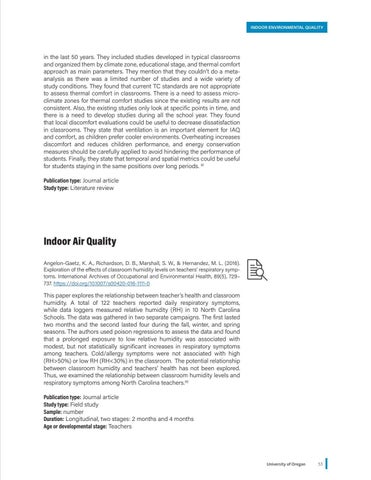INDOOR ENVIRONMENTAL QUALITY
in the last 50 years. They included studies developed in typical classrooms and organized them by climate zone, educational stage, and thermal comfort approach as main parameters. They mention that they couldn’t do a metaanalysis as there was a limited number of studies and a wide variety of study conditions. They found that current TC standards are not appropriate to assess thermal comfort in classrooms. There is a need to assess microclimate zones for thermal comfort studies since the existing results are not consistent. Also, the existing studies only look at specific points in time, and there is a need to develop studies during all the school year. They found that local discomfort evaluations could be useful to decrease dissatisfaction in classrooms. They state that ventilation is an important element for IAQ and comfort, as children prefer cooler environments. Overheating increases discomfort and reduces children performance, and energy conservation measures should be carefully applied to avoid hindering the performance of students. Finally, they state that temporal and spatial metrics could be useful for students staying in the same positions over long periods. 91 Publication type: Journal article Study type: Literature review
Indoor Air Quality Angelon-Gaetz, K. A., Richardson, D. B., Marshall, S. W., & Hernandez, M. L. (2016). Exploration of the effects of classroom humidity levels on teachers’ respiratory symptoms. International Archives of Occupational and Environmental Health, 89(5), 729– 737. https://doi.org/10.1007/s00420-016-1111-0
This paper explores the relationship between teacher’s health and classroom humidity. A total of 122 teachers reported daily respiratory symptoms, while data loggers measured relative humidity (RH) in 10 North Carolina Schools. The data was gathered in two separate campaigns. The first lasted two months and the second lasted four during the fall, winter, and spring seasons. The authors used poison regressions to assess the data and found that a prolonged exposure to low relative humidity was associated with modest, but not statistically significant increases in respiratory symptoms among teachers. Cold/allergy symptoms were not associated with high (RH>50%) or low RH (RH<30%) in the classroom. The potential relationship between classroom humidity and teachers’ health has not been explored. Thus, we examined the relationship between classroom humidity levels and respiratory symptoms among North Carolina teachers.92 Publication type: Journal article Study type: Field study Sample: number Duration: Longitudinal, two stages: 2 months and 4 months Age or developmental stage: Teachers
University of Oregon
53
